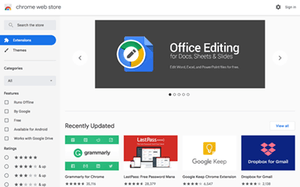Chrome Web Store
The Chrome Web Store (CWS) is Google's online store for its Chrome web browser. As of 2019, CWS hosts about 190,000 extensions and web apps.[1]
 | |
 Chrome Web Store as seen from Chrome | |
| Launch date | December 2010 |
|---|---|
| Website | chrome.google.com/webstore |
History
CWS was publicly unveiled in December 2010,[2] and was opened on February 11, 2011, with the release of Google Chrome 9.0.[3] A year later it was redesigned to "catalyze a big increase in traffic, across downloads, users, and total number of apps".[4] As of June 2012, there were 750 million total installs of content hosted on CWS.[5]
Some extension developers have sold their extensions to third-parties who then incorporated adware.[6][7] In 2014, Google removed two such extensions from CWS after many users complained about unwanted pop-up ads.[8] The following year, Google acknowledged that about five percent of visits to its own websites had been altered by extensions with adware.[9][10][11]
Malware
Malware remains a problem on CWS.[12][13][14][15] In January 2018, security researchers found four malicious extensions with more than 500,000 combined downloads.[12][16]
Chrome used to allow extensions hosted on CWS to also be installed at the developer's website for the sake of convenience.[17] But this became a malware vector, so it was removed in 2018.[18]
References
- "Breaking Down the Chrome Web Store". Extension Monitor. Retrieved 7 August 2019.
- Kincaid, Jason. "Sales Are At A Trickle On Google's Chrome Web Store". TechCrunch. Retrieved 4 January 2011.
- Kay, Erik; Boodman, Aaron (February 3, 2011). "A dash of speed, 3D and apps". Chrome Blog. Google. Retrieved March 9, 2017.
- Empson, Rip. "New Chrome Web Store Proves To Be A Boon For Developers Above (And Below) The Fold". TechCrunch. Retrieved 5 December 2011.
- Vikas SN (2012-06-29). "The Lowdown: Google I/O 2012 Day 2 – 310M Chrome Users, 425M Gmail & More". MediaNama. Retrieved 2013-06-14.
- "Adware vendors buy Chrome Extensions to send ad- and malware-filled updates". Ars Technica. Retrieved 20 January 2014.
- Bruce Schneier (21 Jan 2014). "Adware Vendors Buy and Abuse Chrome Extensions".
- Winkler, Rolfe. "Google Removes Two Chrome Extensions Amid Ad Uproar". blogs.wsj.com. Wall Street Journal. Retrieved 17 March 2014.
- "Ad Injection at Scale: Assessing Deceptive Advertisement Modifications" (PDF). Archived from the original (PDF) on 2015-06-05.
- "Superfish injects ads into 5 percent of all Google page views". PC World. IDG.
- "Superfish injects ads in one in 25 Google page views". CIO. IDG.
- "Security firm ICEBRG uncovers 4 malicious Chrome extensions - gHacks Tech News". www.ghacks.net. Retrieved 2018-12-15.
- "Google's bad track record of malicious Chrome extensions continues - gHacks Tech News". www.ghacks.net. Retrieved 2018-12-15.
- "Chrome Extension Devs Use Sneaky Landing Pages after Google Bans Inline Installs". BleepingComputer. Retrieved 2018-12-15.
- "Chrome's inline extension install ban already bypassed - gHacks Tech News". www.ghacks.net. Retrieved 2018-12-15.
- "Google Chrome extensions with 500,000 downloads found to be malicious". Ars Technica. Retrieved 2018-12-30.
- "Using Inline Installation - Google Chrome". developer.chrome.com. Retrieved 2018-12-14.
- "Improving extension transparency for users". Chromium Blog. Retrieved 2018-12-15.